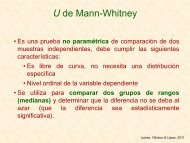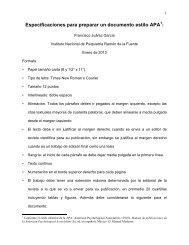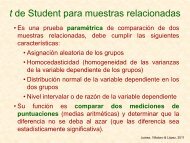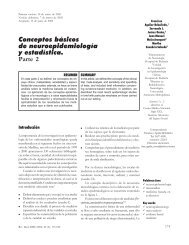- Page 3: Essentialsof Statistics for the Soc
- Page 6 and 7: Essentials of Behavioral Science Se
- Page 8 and 9: Copyright © 2004 by John Wiley & S
- Page 11 and 12: CONTENTSSeries PrefaceixOne Descrip
- Page 13 and 14: SERIES PREFACEIn the Essentials of
- Page 15: Essentials of Statistics for the So
- Page 18 and 19: 2 ESSENTIALS OF STATISTICSDON’T F
- Page 20 and 21: 4 ESSENTIALS OF STATISTICSeral minu
- Page 22 and 23: 6 ESSENTIALS OF STATISTICSphobic an
- Page 26 and 27: 10 ESSENTIALS OF STATISTICSbe said
- Page 28 and 29: 12 ESSENTIALS OF STATISTICSWhen a n
- Page 30 and 31: 14 ESSENTIALS OF STATISTICSThe prob
- Page 32 and 33: 16 ESSENTIALS OF STATISTICSTHE NORM
- Page 34 and 35: 18 ESSENTIALS OF STATISTICSmore sha
- Page 36 and 37: 20 ESSENTIALS OF STATISTICSRapid Re
- Page 38 and 39: 22 ESSENTIALS OF STATISTICScome con
- Page 40 and 41: 24 ESSENTIALS OF STATISTICSThe heig
- Page 42 and 43: S26 ESSENTIALS OF STATISTICSSTEST Y
- Page 44 and 45: TwoINTRODUCTION TO NULLHYPOTHESIS T
- Page 46 and 47: 30 ESSENTIALS OF STATISTICSsample i
- Page 48 and 49: 32 ESSENTIALS OF STATISTICSStandard
- Page 50 and 51: 34 ESSENTIALS OF STATISTICSfor smal
- Page 52 and 53: 36 ESSENTIALS OF STATISTICSIt is ge
- Page 54 and 55: 38 ESSENTIALS OF STATISTICSis not n
- Page 56 and 57: 40 ESSENTIALS OF STATISTICSthe othe
- Page 58 and 59: 42 ESSENTIALS OF STATISTICSing with
- Page 60 and 61: 44 ESSENTIALS OF STATISTICSuse Gree
- Page 62 and 63: S46 ESSENTIALS OF STATISTICS(c) Bas
- Page 64 and 65: ThreeTHE TWO-GROUP t TESTTHE INDEPE
- Page 66 and 67: 50 ESSENTIALS OF STATISTICSsults co
- Page 68 and 69: 52 ESSENTIALS OF STATISTICSestimate
- Page 70 and 71: 54 ESSENTIALS OF STATISTICSThe Pool
- Page 72 and 73: 56 ESSENTIALS OF STATISTICSslightly
- Page 74 and 75:
58 ESSENTIALS OF STATISTICSsample o
- Page 76 and 77:
60 ESSENTIALS OF STATISTICSCAUTIONA
- Page 78 and 79:
62 ESSENTIALS OF STATISTICSpowerful
- Page 80 and 81:
64 ESSENTIALS OF STATISTICSless you
- Page 82 and 83:
66 ESSENTIALS OF STATISTICSDON’T
- Page 84 and 85:
68 ESSENTIALS OF STATISTICStwo age
- Page 86 and 87:
70 ESSENTIALS OF STATISTICS7. Compa
- Page 88 and 89:
72 ESSENTIALS OF STATISTICSDON’T
- Page 90 and 91:
74 ESSENTIALS OF STATISTICSz scores
- Page 92 and 93:
76 ESSENTIALS OF STATISTICSthe odd-
- Page 94 and 95:
78 ESSENTIALS OF STATISTICSnull hyp
- Page 96 and 97:
80 ESSENTIALS OF STATISTICSof any t
- Page 98 and 99:
82 ESSENTIALS OF STATISTICSMaximumr
- Page 100 and 101:
84 ESSENTIALS OF STATISTICSCAUTIONS
- Page 102 and 103:
86 ESSENTIALS OF STATISTICSchange i
- Page 104 and 105:
88 ESSENTIALS OF STATISTICSCAUTIONT
- Page 106 and 107:
90 ESSENTIALS OF STATISTICStal line
- Page 108 and 109:
92 ESSENTIALS OF STATISTICSis relat
- Page 110 and 111:
Putting It Into Practice1. As the c
- Page 112 and 113:
96 ESSENTIALS OF STATISTICS5. If a
- Page 115 and 116:
ONE-WAY ANOVA AND MULTIPLE COMPARIS
- Page 117 and 118:
ONE-WAY ANOVA AND MULTIPLE COMPARIS
- Page 119 and 120:
ONE-WAY ANOVA AND MULTIPLE COMPARIS
- Page 121 and 122:
ONE-WAY ANOVA AND MULTIPLE COMPARIS
- Page 123 and 124:
ONE-WAY ANOVA AND MULTIPLE COMPARIS
- Page 125 and 126:
ONE-WAY ANOVA AND MULTIPLE COMPARIS
- Page 127 and 128:
ONE-WAY ANOVA AND MULTIPLE COMPARIS
- Page 129 and 130:
ONE-WAY ANOVA AND MULTIPLE COMPARIS
- Page 131 and 132:
ONE-WAY ANOVA AND MULTIPLE COMPARIS
- Page 133 and 134:
ONE-WAY ANOVA AND MULTIPLE COMPARIS
- Page 135 and 136:
ONE-WAY ANOVA AND MULTIPLE COMPARIS
- Page 137 and 138:
ONE-WAY ANOVA AND MULTIPLE COMPARIS
- Page 139 and 140:
POWER ANALYSIS 123DON’T FORGETWhe
- Page 141 and 142:
POWER ANALYSIS 125make effect size
- Page 143 and 144:
POWER ANALYSIS 127 8 2 1.5 2 1.5
- Page 145 and 146:
POWER ANALYSIS 129other treatments
- Page 147 and 148:
POWER ANALYSIS 131To attain a power
- Page 149 and 150:
POWER ANALYSIS 133Note that Formula
- Page 151 and 152:
POWER ANALYSIS 135of each populatio
- Page 153 and 154:
POWER ANALYSIS 137Rapid Reference 6
- Page 155 and 156:
POWER ANALYSIS 139nificant. If each
- Page 157 and 158:
POWER ANALYSIS 141method A gives us
- Page 159 and 160:
SPOWER ANALYSIS 143(b) If the two g
- Page 161 and 162:
SevenFACTORIAL ANOVATWO-WAY ANOVAIn
- Page 163 and 164:
FACTORIAL ANOVA 147want to test two
- Page 165 and 166:
FACTORIAL ANOVA 149Method IMethod I
- Page 167 and 168:
FACTORIAL ANOVA 151The SS Component
- Page 169 and 170:
FACTORIAL ANOVA 153time you will ha
- Page 171 and 172:
FACTORIAL ANOVA 155fore, leads to a
- Page 173 and 174:
FACTORIAL ANOVA 157less interesting
- Page 175 and 176:
FACTORIAL ANOVA 159texts B and C yo
- Page 177 and 178:
FACTORIAL ANOVA 161affected by a co
- Page 179 and 180:
FACTORIAL ANOVA 163the simple inter
- Page 181 and 182:
FACTORIAL ANOVA 165cated. If no int
- Page 183 and 184:
FACTORIAL ANOVA 167sual method (rel
- Page 185 and 186:
SFACTORIAL ANOVA 169Subvocal Instru
- Page 187 and 188:
FACTORIAL ANOVA 17110. For a 2 2
- Page 189 and 190:
REPEATED-MEASURES ANOVA 173Table 8.
- Page 191 and 192:
REPEATED-MEASURES ANOVA 175Rapid Re
- Page 193 and 194:
REPEATED-MEASURES ANOVA 177value us
- Page 195 and 196:
REPEATED-MEASURES ANOVA 179talizes
- Page 197 and 198:
REPEATED-MEASURES ANOVA 181of 24 (i
- Page 199 and 200:
REPEATED-MEASURES ANOVA 183are met)
- Page 201 and 202:
REPEATED-MEASURES ANOVA 185nore the
- Page 203 and 204:
REPEATED-MEASURES ANOVA 187the F ra
- Page 205 and 206:
REPEATED-MEASURES ANOVA 189Assumpti
- Page 207 and 208:
REPEATED-MEASURES ANOVA 191creasing
- Page 209 and 210:
REPEATED-MEASURES ANOVA 193Happy mu
- Page 211 and 212:
REPEATED-MEASURES ANOVA 195Putting
- Page 213 and 214:
REPEATED-MEASURES ANOVA 1973. If an
- Page 215 and 216:
NineNONPARAMETRIC STATISTICSMuch of
- Page 217 and 218:
NONPARAMETRIC STATISTICS 201cause t
- Page 219 and 220:
NONPARAMETRIC STATISTICS 203the two
- Page 221 and 222:
NONPARAMETRIC STATISTICS 205sult wi
- Page 223 and 224:
NONPARAMETRIC STATISTICS 207The Tai
- Page 225 and 226:
NONPARAMETRIC STATISTICS 209Table 9
- Page 227 and 228:
NONPARAMETRIC STATISTICS 211Fisher
- Page 229 and 230:
tives can be categorized as to thei
- Page 231 and 232:
NONPARAMETRIC STATISTICS 215ranks f
- Page 233 and 234:
NONPARAMETRIC STATISTICS 217Finally
- Page 235 and 236:
NONPARAMETRIC STATISTICS 219where N
- Page 237 and 238:
NONPARAMETRIC STATISTICS 221gist wh
- Page 239 and 240:
NONPARAMETRIC STATISTICS 223(a) Per
- Page 241 and 242:
NONPARAMETRIC STATISTICS 2256. In a
- Page 243 and 244:
APPENDIX A 227Table A.1 Continuedz
- Page 245 and 246:
APPENDIX A 229Table A.1Continuedz M
- Page 247 and 248:
APPENDIX A 231αα/2α/20 tOne-tail
- Page 249 and 250:
α = .050FTable A.3 Critical Values
- Page 251 and 252:
Table A.4 Critical Values of the St
- Page 253 and 254:
APPENDIX A 237Table A.5 Power as a
- Page 255 and 256:
APPENDIX A 239Table A.6 Power of AN
- Page 257 and 258:
APPENDIX A 241Alpha0X 2Table A.7 Cr
- Page 259 and 260:
Appendix B: Answers to Putting It I
- Page 261 and 262:
APPENDIX B 245Chapter 21. (a) X 96.
- Page 263 and 264:
Separate-variances t test:29.63 - 2
- Page 265 and 266:
D 2.5 2.5t 1 .0 36 2.41 2 .93 8t
- Page 267 and 268:
APPENDIX B 251(c)864Stats20-2-20 2
- Page 269 and 270:
APPENDIX B 253 pc EWc .0 56 .
- Page 271 and 272:
Chapter 61. (a) From Table A.5, 2.8
- Page 273 and 274:
APPENDIX B 257(b) From Table A.5, 2
- Page 275 and 276:
APPENDIX B 259Women:F 11 3 102 1
- Page 277 and 278:
APPENDIX B 261 77.2 742.4. Therefo
- Page 279 and 280:
APPENDIX B 2634. Cell Means for Eye
- Page 281 and 282:
APPENDIX B 265(b) No. Ignore Sound
- Page 283 and 284:
APPENDIX B 267(d) Cell Means by Typ
- Page 285 and 286:
APPENDIX B 269You can see some inte
- Page 287 and 288:
APPENDIX B 271Notes that the z from
- Page 289 and 290:
Sz s- .5(n s)(N 1) 39.5 - .5(7)(1
- Page 291 and 292:
ReferencesAlgina, J., & Keselman, H
- Page 293 and 294:
REFERENCES 277Tukey, J. W. (1969).
- Page 295:
ANNOTATED BIBLIOGRAPHY 279to use wh
- Page 298 and 299:
282 INDEXANOVA (continued )nested d
- Page 300 and 301:
284 INDEXDunnett test. See Multiple
- Page 302 and 303:
286 INDEXMultiple comparisons (cont
- Page 304 and 305:
288 INDEXSampling:descriptive stati
- Page 307:
AcknowledgmentsBarry Cohen would li












